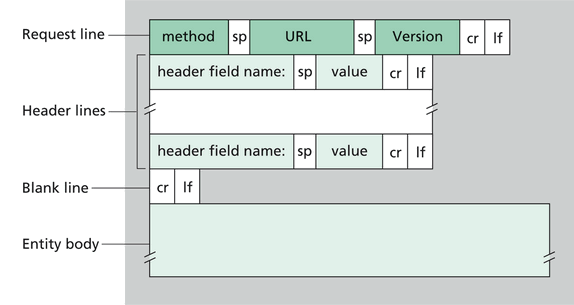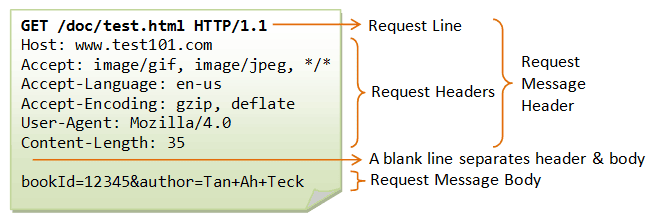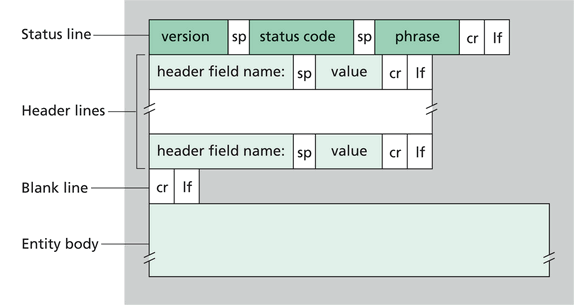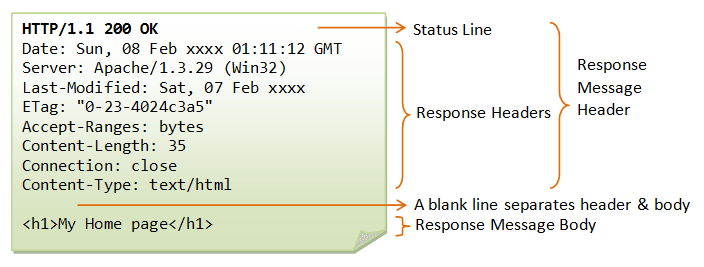HTTP 协议应用指导
HTTP 简介
HTTP协议
HTTP(Hyper Text Transformer Protocol,超文本传输协议)是一种由客户端发起请求,通过 URL(Uniform Resource Locator,统一资源定位符)来访问服务器资源的一种通信协议。该协议基于 C/S 模型,以文本的形式组织请求和响应的报文。通信模型如下:

HTTP 协议的主要应用场景有:基于浏览器的网页获取与表单提交、文件上传与下载、移动应用、物联网设备的数据上报等。
请求和响应报文
请求报文
HTTP 请求报文的格式如下:

Request line:请求行,由method、URL、Version字段组成。method:请求方法,常用的方法有 GET、POST、PUT、HEAD、DELETE 等,详见下文。URL:统一资源定位符,用于标识服务器资源的路径。Version:协议版本,目前常用的版本为HTTP/1.1。
Header lines:请求首部,由一个或多个头域组成,每个头域的格式为header field name: value。head field name:头域的名称。value:头域的值。
Entity body:消息体,即向服务器传递的消息正文。
值得注意的是,图中的
sp表示空格,crlf表示回车与换行,请求首部与消息体之间必须插入一行空行,即图示的Blank line。
请求报文的示例如下:

响应报文
HTTP 响应报文的格式如下:

Status line:响应状态行,由version、status code、phrase字段组成。version:协议版本,目前常用的版本为HTTP/1.1。status code:响应状态码,详见下文。phrase:原因短语。
Header lines:响应首部,由一个或多个头域组成,每个头域的格式为header field name: value。head field name:头域的名称。value:头域的值。
Entity body:消息体,即服务器响应的消息正文。
值得注意的是,图中的
sp表示空格,crlf表示回车与换行,响应首部与消息体之间必须插入一行空行,即图示的Blank line。
响应报文的示例如下:

HTTP 请求方法
HTTP 常用的方法有 GET、POST、PUT、HEAD、DELETE 等。
GET:HTTP 请求中最常用的方法,用于向服务器请求获取资源。
HEAD:和 GET 方法一样,但是不返回报文实体主体部分。主要用于确认 URL 的有效性以及资源更新的日期时间等。
PUT:用于向服务器上传资源,当资源不存在时则创建资源,否则会替换资源。
POST:用于修改服务器资源,当资源不存在时则创建资源,否则会修改资源。
DELETE:删除资源,与 PUT 功能相反。
HTTP 状态码
服务器返回的响应报文中第一行为状态行,包含了状态码以及原因短语,用来告知客户端请求的结果。
| 状态码 | 类别 | 原因短语 |
|---|---|---|
| 1xx | Informational(信息性状态码) | 接收的请求正在处理 |
| 2xx | Success(成功状态码) | 请求正常处理完毕 |
| 3xx | Redirection(重定向状态码) | 需要进行附加操作以完成请求 |
| 4xx | Client Error(客户端错误状态码) | 服务器无法处理请求 |
| 5xx | Server Error(服务器错误状态码) | 服务器处理请求出错 |
HTTP 协议的具体内容请参考国际互联网工程任务组的官方文档。
HTTP 协议与 TCP 协议的区别与联系:
HTTP 协议是基于 TCP 协议实现的。
TCP 协议面向字节流,用户无法很好地确定业务数据的边界;而 HTTP 协议具有特定的报文格式,而且用户业务数据可通过
Content-Length: ${Length}头域来指定用户数据长度,或通过Transfer-Encoding:chunked头域来指定用户数据编码格式,两种方式均可确定业务数据的边界。QuecPython 模组已同时支持对Content-Length: ${Length}和Transfer-Encoding:chunked两种方式的解析。
HTTP 应用
连接网络
启动 HTTP 应用之前,首先要确保网络畅通。
而 QuecPython 相关模组在上电后会自动进行蜂窝网络连接。因此,一般情况下开发者只需在应用中检测网络状态即可,示例代码如下:
import checkNet
if __name__ == '__main__':
stage, state = checkNet.waitNetworkReady(30)
if stage == 3 and state == 1:
print('Network connection successful.')
else:
print('Network connection failed, stage={}, state={}'.format(stage, state))
如果网络连接异常,可参考网络拨号相关的应用指导,重新进行网络连接。
HTTP 请求代码示例
HTTP GET 请求
本节以 GET 和 POST 请求为例,展示了最基础的 HTTP 请求代码编写。
首先以 GET 请求为例,示例代码如下:
import request
# Construct an HTTP GET request
url = 'http://api.example.com/resource'
# Set the request header to JSON. if the header is not set, the default value is application/json
headers = {'Content-Type': 'application/json'}
# Send the HTTP GET request
response = request.get(url, headers=headers)
# Get the HTTP response status
status_code = response.status_code
print('GET status code:', status_code)
# Get the HTTP response data
data = response.json()
print('GET response data:', data)
HTTP POST 请求
由于 GET 请求是向服务器请求资源,请求报文中一般无需携带消息体。
而 POST 请求则用于向服务器推送消息,需要携带消息体,示例代码如下:
import request
import ujson
# Construct an HTTP POST request
url = 'http://api.example.com/resource'
# Set the request header to JSON
headers = {'Content-Type': 'application/json'}
# Construct the request data
payload = {'key1': 'value1', 'key2': 'value2'}
json_payload = ujson.dumps(payload)
# Send the HTTP POST request
response = request.post(url, headers=headers, data=json_payload)
# Get the HTTP response status
status_code = response.status_code
print('POST status code:', status_code)
# Get the HTTP response data
data = response.json()
print('POST response data:', data)
上述两段代码可以看出,GET 和 POST 请求的代码在编写时有两个主要区别:
request模块后使用的方法不同,分别是request.get()和request.post()。- POST 请求需要构建请求数据,而 GET 请求不需要。
其余编程的思路几乎一样,服务器响应后,HTTP 请求返回响应对象response。通过response提供的方法,可以获取 HTTP 的响应码、原因短语、响应消息体等数据。
HTTP 请求常用接口
本节讲述下request.get()、request.post()和响应结果response对象常用方法的使用说明。
request.get()函数原型:request.get(url, data=None, **kwargs)request.post()函数原型:request.post(url, data=None, **kwargs)response类型:<class 'Response'>- 参数说明:
url:位置参数,服务器资源地址。data:默认参数,请求报文的消息体。**kwargs:关键字参数,HTTP 请求其它的相关参数。headers:请求头,字典类型。decode:是否将响应结果进行 utf-8 解码,布尔类型,默认值为True。sizeof:读取缓冲区的数据块大小,默认 255 个字节,建议 255-4096,数值越大读取的速度越快。ssl_params:SSL 证书参数,格式为:{"cert": certificate_content, "key": private_content}。
- 返回值:
<class 'Response'>类型的对象response。该响应对象的属性和方法如下:status_code:响应状态码,int 类型。headers:响应头,dict 类型。text:响应消息体的字符串类型生成器。json:将响应的 json 消息体转换为 dict 类型。content:响应消息体的 bytes 类型生成器。
HTTP 应用范例
天气查询
高德开放天气查询接口:http://restapi.amap.com/v3/weather/weatherInfo?key=2875b8171f67f3be3140c6779f12dcba&city=北京&extensions=base
北京可替换为其他国内城市名称。
调用 HTTP GET 方法可查询指定城市的天气,示例代码如下(点此在 github 中下载完整代码):
import request
# Weather query URL
url = 'http://restapi.amap.com/v3/weather/weatherInfo?key=2875b8171f67f3be3140c6779f12dcba&city=北京&extensions=base'
# Send the HTTP GET request
response = request.get(url)
# Get the raw data returned by the weather query website
data = ''
for i in response.text:
data += i
print('raw data responsed from website:')
print(data)
以上代码的执行结果为:
raw data responsed from website:
{"status":"1","count":"1","info":"OK","infocode":"10000","lives":[{"province":"北京","city":"北京市","adcode":"110000","weather":"阴","temperature":"36","winddirection":"东南","windpower":"≤3","humidity":"34","reporttime":"2023-07-02 18:40:39","temperature_float":"36.0","humidity_float":"34.0"}]}
想进一步处理该数据,比如美化输出,可以调用response对象的json方法(点此在 github 中下载完整代码):
import request
# Weather query URL
url = 'http://restapi.amap.com/v3/weather/weatherInfo?key=2875b8171f67f3be3140c6779f12dcba&city=北京&extensions=base'
# Send the HTTP GET request
response = request.get(url)
# Get raw data from the website and parse it into a dict type by calling the json() method of response object
data = response.json()
data = data['lives'][0]
for k,v in data.items():
print('%s: %s' % (k, v))
以上代码的执行结果为:
province: 北京
city: 北京市
adcode: 110000
weather: 阴
temperature: 36
winddirection: 东南
windpower: ≤3
humidity: 34
reporttime: 2023-07-02 18:40:39
temperature_float: 36.0
humidity_float: 34.0
文件下载
此处以下载百度搜索首页的 html 网页文件为例进行演示,发送请求的代码如下(点此在 github 中下载完整代码):
import request
# Baidu URL over HTTP protocol (not HTTPS)
url = 'http://www.baidu.com'
# Send the HTTP GET request
response = request.get(url)
在读取网页数据前,在模组的 /usr 目录下以wb的模式创建一个名为baidu.html的文件:
# Create file baidu.html
f = open('/usr/baidu.html', 'wb') # 'wb' means writing binary data
网页文件可能会包含一些超出 ASCII 范围的字符,在获取响应数据时,建议使用request.content,而不是request.text。
代码如下:
# Get web page content and write to the file
for i in response.content:
f.write(i)
# Close the file after fetching the web page data
f.close()
至此文件下载完毕。
想要查看下载的文件内容,执行以下代码即可:
# Open file baidu.html
with open('/usr/baidu.html', 'rb') as f: # 'rb' means reading the file in binary mode
r = f.read()
while r:
print(r)
r = f.read()
# Close the file
f.close()
打印的文件内容如下:
b'<!DOCTYPE html>\r\n<!--STATUS OK--><html> <head><meta http-equiv=content-type content=text/html;charset=utf-8><meta http-equiv=X-UA-Compatible content=IE=Edge><meta content=always name=referrer><link rel=stylesheet type=text/css href=http://s1.bdstatic.com/r/www/cache/bdorz/baidu.min.css><title>\xe7\x99\xbe\xe5\xba\xa6\xe4\xb8\x80\xe4\xb8\x8b\xef\xbc\x8c\xe4\xbd\xa0\xe5\xb0\xb1\xe7\x9f\xa5\xe9\x81\x93</title></head> <body link=#0000cc> <div id=wrapper> <div id=head> <div class=head_wrapper> <div class=s_form> <div class=s_form_wrapper> <div id=lg> <img hidefocus=true src=//www.baidu.com/img/bd_logo1.png width=270 height=129> </div> <form id=form name=f action=//www.baidu.com/s class=fm> <input type=hidden name=bdorz_come value=1> <input type=hidden name=ie value=utf-8> <input type=hidden name=f value=8> <input type=hidden name=rsv_bp value=1> <input type=hidden name=rsv_idx value=1> <input type=hidden name=tn value=baidu><span class="bg s_ipt_wr"><input id=kw name=wd class=s_ipt value maxlength=255 autocomplete=off autofocus></span><span class="bg s_btn_wr"><input type=submit id=su value=\xe7\x99\xbe\xe5\xba\xa6\xe4\xb8\x80\xe4\xb8\x8b class="bg s_btn"></span> </form> </div> </div> <div id=u1> <a href=http://news.baidu.com name=tj_trnews class=mnav>\xe6\x96\xb0\xe9\x97\xbb</a> <a href=http://www.hao123.com name=tj_trhao123 class=mnav>hao123</a> <a href=http://map.baidu.com name=tj_trmap class=mnav>\xe5\x9c\xb0\xe5\x9b\xbe</a> <a href=http://v.baidu.com name=tj_trvideo class=mnav>\xe8\xa7\x86\xe9\xa2\x91</a> <a href=http://tieba.baidu.com name=tj_trtieba class=mnav>\xe8\xb4\xb4\xe5\x90\xa7</a> <noscript> <a href=http://www.baidu.com/bdorz/login.gif?login&tpl=mn&u=http%3A%2F%2Fwww.baidu.com%2f%3fbdorz_come%3d1 name=tj_login class=lb>\xe7\x99\xbb\xe5\xbd\x95</a> </noscript> <script>document.write(\'<a href="http://www.baidu.com/bdorz/login.gif?login&tpl=mn&u=\'+ encodeURIComponent(window.location.href+ (window.location.search === "" ? "?" : "&")+ "bdorz_come=1")+ \'" name="tj_login" class="lb">\xe7\x99\xbb\xe5\xbd\x95</a>\');</script> <a href=//www.baidu.com/more/ name=tj_briicon class=bri style="display: block;">\xe6\x9b\xb4\xe5\xa4\x9a\xe4\xba\xa7\xe5\x93\x81</a> </div> </div> </div> <div id=ftCon> <div id=ftConw> <p id=lh> <a href=http://home.baidu.com>\xe5\x85\xb3\xe4\xba\x8e\xe7\x99\xbe\xe5\xba\xa6</a> <a href=http://ir.baidu.com>About Baidu</a> </p> <p id=cp>©2017 Baidu <a href=http://www.baidu.com/duty/>\xe4\xbd\xbf\xe7\x94\xa8\xe7\x99\xbe\xe5\xba\xa6\xe5\x89\x8d\xe5\xbf\x85\xe8\xaf\xbb</a> <a href=http://jianyi.baidu.com/ class=cp-feedback>\xe6\x84\x8f\xe8\xa7\x81\xe5\x8f\x8d\xe9\xa6\x88</a> \xe4\xba\xacICP\xe8\xaf\x81030173\xe5\x8f\xb7 <img src=//www.baidu.com/img/gs.gif> </p> </div> </div> </div> </body> </html>\r\n'
multipart/form-data 表单提交
HTTP 的multipart/form-data形式的表单提交在 HTTP 通信中很常用,可用于文件上传。需要在请求首部中增加Content-Type: multipart/form-data;boundary=${Boundary}头域,完整格式如下:
POST / HTTP/1.1
host: www.example.com
Content-Type: multipart/form-data; boundary=${Boundary}
--${Boundary}
Content-Disposition: form-data; name="text"
title
--${Boundary}
Content-Disposition: form-data; name="file"; filename="test.png"
Content-Type: image/png
<binary data of the image>
--${Boundary}--
上述表单请求报文实现的是 test.png 文件的上传,同时增加了一个表单字段text,它的值为title。
报文格式说明如下:
${Boundary}:请求方自行设置的分隔字符串,比如----WebKitFormBoundaryrGKCBY7qhFd3TrwA。请求的消息体由多个
--${Boundary}分隔的表单项组成,每个表单项又由请求头和消息体组成,格式为:--${Boundary} Content-Disposition: form-data; name="parameter_name" Parameter value--${Boundary}后追加回车换行符crlf。每个请求头后也追加回车换行符
crlf。请求头与消息体(即上述的参数值)之间也追加一行空行,即
crlf。
如果表单项中携带的是文件数据:
- Content-Disposition 头域后需追加 filename 字段,如
Content-Disposition: form-data; name="file"; filename="test.png",表明表单携带的是文件内容,文件名称为 test.png。 - 需追加 Content-Type 请求头,表明文件类型,如
Content-Type: image/png。
- Content-Disposition 头域后需追加 filename 字段,如
在所有表单的最后,以
--${Boundary}--结尾。
在 QuecPython 中实现此类型的表单,需要用户自行组织完整的表单格式消息体,示例代码如下(点此在 github 中下载完整代码):
import request
url = 'http://www.example.com'
boundary = '----WebKitFormBoundaryrGKCBY7qhFd3TrwA'
headers = {'Content-Type': 'multipart/form-data; boundary=' + boundary}
data = ''
data += '--' + boundary + '\r\n'
data += 'Content-Disposition: form-data; name="text"\r\n'
data += '\r\n'
data += 'title\r\n'
data += '--' + boundary + '\r\n'
data += 'Content-Disposition: form-data; name="file"; filename="test.png"\r\n'
data += 'Content-Type: image/png\r\n'
data += '\r\n'
data = bytes(data.encode())
with open('/usr/test.png', 'rb') as f:
data += f.read()
data += b'\r\n'
data += b'--' + bytes(boundary.encode()) + b'--'
request.post(url, headers=headers, data=data)
application/x-www-form-urlencoded 表单提交
另一种表单形式application/x-www-form-urlencoded在 HTTP 通信中也很常用。
- 在请求首部中增加头域
Content-Type: application/x-www-form-urlencoded; charset=utf-8,其中字符集编码格式按需取舍,一般网络数据传输均以 utf-8 编码,增加该字符集编码无副作用。 - 消息体的格式为
key1=value1&key2=value2。
可以看出该种形式的表单格式很简单,较为完整的报文如下:
POST / HTTP/1.1
host: www.example.com
Content-Type: application/x-www-form-urlencoded; charset=utf-8
key1=value1&key2=value2
JSON 表单提交
物联网设备使用 HTTP 协议上报数据时,最常见的就是以 JSON 格式进行上报。
HTTP 常见问题
1. 用 POST 方法向百度或其他服务器提交数据时,报如下错误怎么办?
Traceback (most recent call last):
File "<stdin>", line 1, in <module>
File "request.py", line 272, in post
File "request.py", line 252, in request
NotImplementedError: Redirects not yet supported
QuecPython 的 HTTP 请求暂未支持 URL 重定向,请使用最终有效的 URL 进行数据提交。
2. HTTP POST 的消息体格式与 Content-Type 头域的对应关系是怎样的?
| Content-Type 头域的值 | 消息体格式 |
|---|---|
| text/plain | 纯文本 |
| text/html; charset=utf-8 | html格式 |
| application/json | json格式 |
| application/xml | xml格式 |
| application/x-www-form-urlencoded; charset=utf-8 | key1=value1&key2=value2 |
| multipart/form-data; boundary=${Boundary} | 点此查看 |
| image/jpeg | jpeg格式的图像数据 |
| audio/mpeg | mpeg格式的音频数据 |
